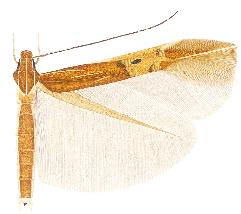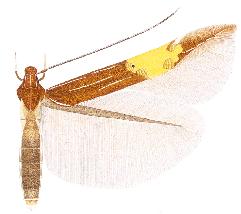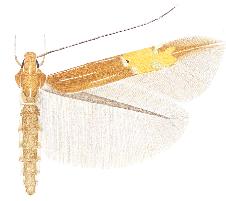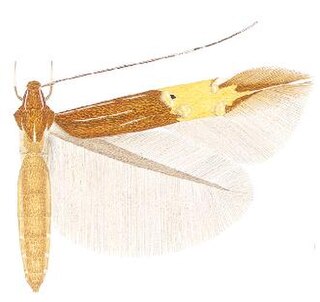
Zizula hylax, 'the Tiny grass blue' is a species of blue butterfly.

Appias lalage, the spot puffin, is a small butterfly of the family Pieridae, that is, the yellows and whites, which is found in India, Indochina and Hainan.

Appias indra, the plain puffin, is a small butterfly of the family Pieridae, that is, the yellows and whites, which is found in south and southeast Asia.

Hypolimnas misippus, the Danaid eggfly, mimic, or diadem, is a widespread species of nymphalid butterfly. It is well known for polymorphism and mimicry. Males are blackish with distinctive white spots that are fringed in blue. Females are in multiple forms that include male-like forms while others closely resemble the toxic butterflies Danaus chrysippus and Danaus plexippus.

Prosotas noreia, the white-tipped lineblue, is a species of lycaenid butterfly found in South Asia and Java.

Chliaria othona, the orchid tit, is a species of lycaenid or blue butterfly found in Asia.

Cosmopterix fernaldella is a moth of the family Cosmopterigidae. It is known from the United States and Canada.

Cosmopterix lespedezae is a moth of the family Cosmopterigidae. It is known from the United States.

Cosmopterix lysithea is a moth of the family Cosmopterigidae. It is known from the Federal District of Brazil.

Cosmopterix pentachorda is a moth of the family Cosmopterigidae. It is known from Ecuador and Peru.

Cosmopterix thelxinoe is a moth of the family Cosmopterigidae. It is known from Brazil and the United States.

Pebobs elara is a moth of the family Cosmopterigidae. It is known from Cuba and Jamaica.

Pebobs ipomoeae is a moth of the family Cosmopterigidae. It is known from Florida.

Pebobs sanctivincenti is a moth of the family Cosmopterigidae. It is known from Grenada and Saint Vincent and the Grenadines.

Pebobs tetragramma is a moth of the family Cosmopterigidae. It is known from Guyana.

Battaristis concinusella is a species of moth in the family Gelechiidae. It is found in North America, including California, Delaware, Illinois, Maryland, Minnesota, North Dakota, Ohio, Ontario, Quebec, South Carolina and West Virginia.
Helcystogramma juventellus is a moth in the family Gelechiidae. It was described by Thomas de Grey, 6th Baron Walsingham, in 1897. It is found in Jamaica and Mexico (Tabasco).
Coleotechnites obliquistrigella is a moth of the family Gelechiidae. It is found in North America, where it has been recorded from Alabama, Florida, Kentucky, Maine, Mississippi, Ohio and Tennessee.
Pseudochelaria walsinghami is a moth of the family Gelechiidae. It was described by Dietz in 1900. It is found in North America, where it has been recorded from Alabama, Arizona, Arkansas, Florida, Illinois, Indiana, Kansas, Kentucky, Maine, Mississippi, Nebraska, North Carolina, Ohio, Pennsylvania, South Carolina and Tennessee.
Battaristis symphora is a moth of the family Gelechiidae. It was described by Walsingham in 1911. It is found in Mexico (Tabasco).







